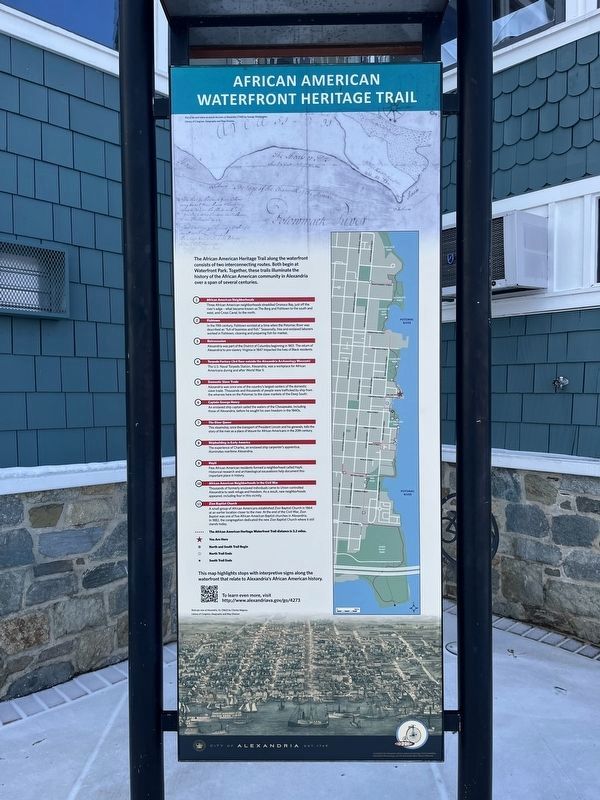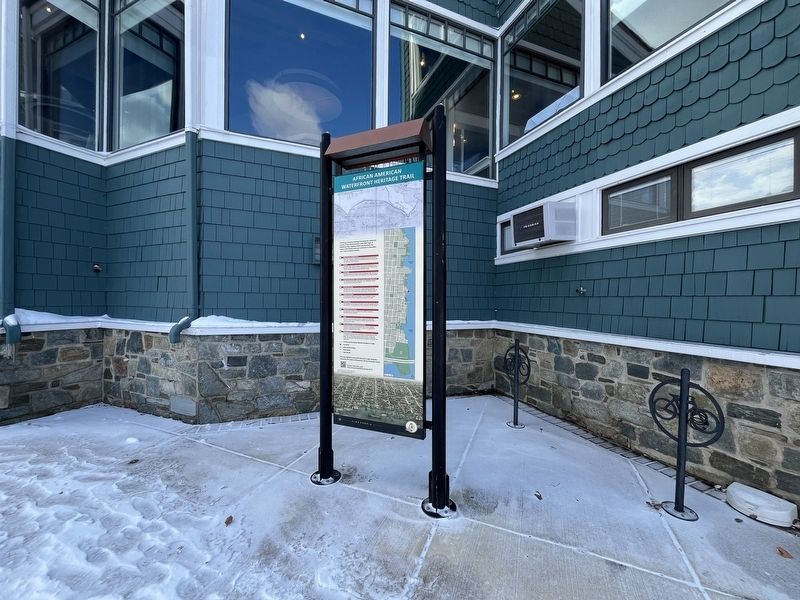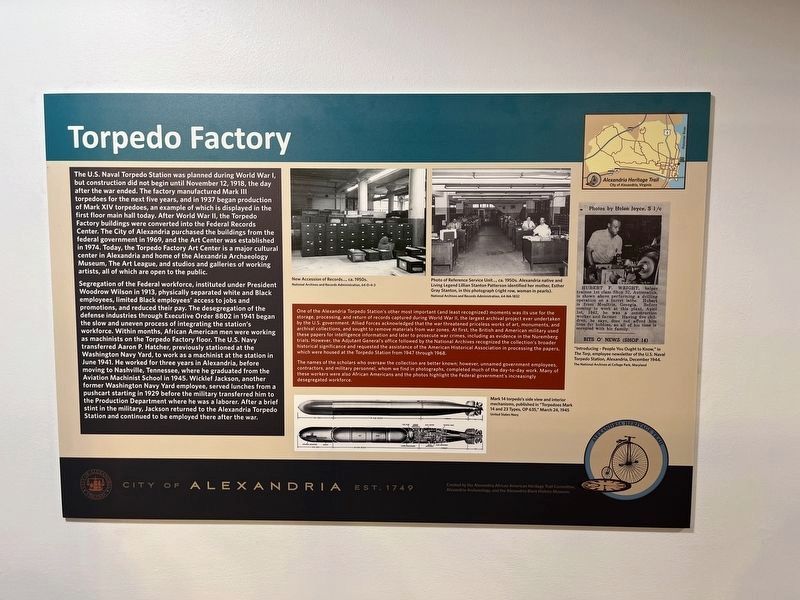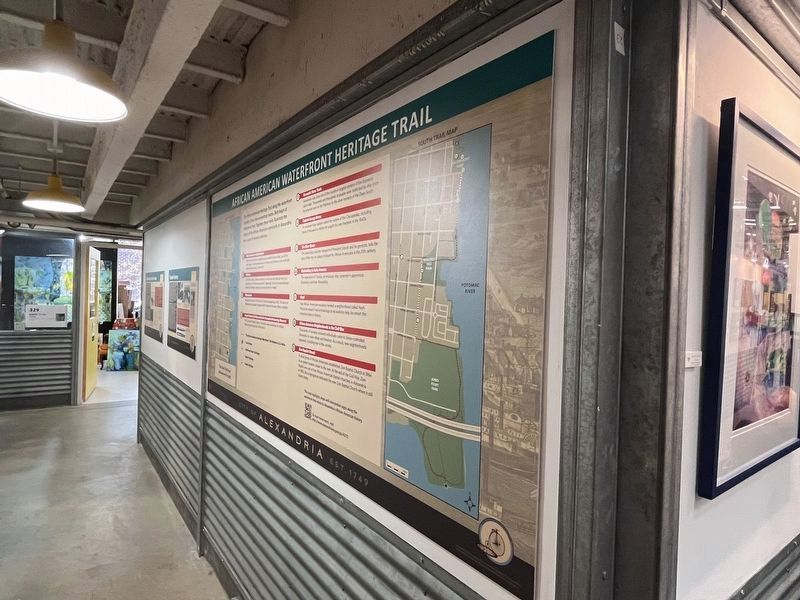Old Town in Alexandria, Virginia — The American South (Mid-Atlantic)
African American Waterfront Heritage Trail
City of Alexandria, Est. 1749
— Alexandria Heritage Trail —

Photographed By Devry Becker Jones (CC0), January 20, 2024
1. African American Waterfront Heritage Trail Marker
The African American Heritage Trail along the waterfront consists of two interconnecting routes. Both begin at Waterfront Park. Together, these trails illuminate the history of the African American community in Alexandria over a span of several centuries.
① African American Neighborhoods
Three African American neighborhoods straddled Oronoco Bay, just off the river's edge — what became known as The Berg and Fishtown to the south and west, and Cross Canal, to the north.
② Fishtown
In the 19th century, Fishtown existed at a time when the Potomac River was described as "full of business and fish." Seasonally, free and enslaved laborers worked in Fishtown, cleaning and preparing fish for market.
③ Retrocession
Alexandria was part of the District of Columbia beginning in 1801. The return of Alexandria to pro-slavery Virginia in 1847 impacted the lives of Black residents.
④ Torpedo Factory (3rd floor outside the Alexandria Archaeology Museum)
The U.S. Naval Torpedo Station, Alexandria, was a workplace for African Americans during and after World War II.
⑤ Domestic Slave Trade
Alexandria was once one of the country's largest centers of domestic slave trade. Thousands and thousands of people were trafficked by ship from the wharves here on the Potomac to the slave markets of the Deep South.
⑥ Captain George Henry
An enslaved ship captain sailed the waters of the Chesapeake, including those of Alexandria, before he sought his own freedom in the 1840s.
⑦ The River Queen
This steamship, once the transport of President Lincoln and his generals, tells the story of the river as a place of leisure for African Americans in the 20th century.
⑧ Shipbuilding in Early America
The experience of Charles, and enslaved ship carpenter's apprentice, illuminates maritime Alexandria.
⑨ Hayti
Free African American residents formed a neighborhood called Hayti. Historical research and archaeological excavations help document this important place in history.
⑩ African American Neighborhoods in the Civil War
Thousands of formerly enslaved individuals came to Union-controlled Alexandria to seek refuge and freedom. As a result, new neighborhoods appeared, including four in this vicinity.
⑪ Zion Baptist Church
A small group of African Americans established Zion Baptist Church in 1864 at an earlier location closer to the river. At the end of the Civil War, Zion Baptist was one of five African American Baptist churches in

Photographed By Devry Becker Jones (CC0), January 20, 2024
2. African American Waterfront Heritage Trail Marker
Erected by City of Alexandria, Virginia. (Marker Number Map.)
Topics and series. This historical marker is listed in these topic lists: African Americans • Industry & Commerce • Settlements & Settlers • Waterways & Vessels. In addition, it is included in the Virginia, The City of Alexandria series list. A significant historical year for this entry is 1801.
Location. 38° 48.331′ N, 77° 2.316′ W. Marker is in Alexandria, Virginia. It is in Old Town. Marker can be reached from Thompsons Alley east of North Union Street, on the right when traveling east. Touch for map. Marker is at or near this postal address: 2 Thompsons Alley, Alexandria VA 22314, United States of America. Touch for directions.
Other nearby markers. At least 8 other markers are within walking distance of this marker. Submarine Screw (Propeller) (within shouting distance of this marker); Engin Artemel (within shouting distance of this marker); Old Town Alexandria (within shouting distance of this marker); Retrocession (about 400 feet away, measured in a direct line); The Civil War Comes to Alexandria (about 400 feet away); Torpedo Factory Art Center (about 500 feet away); Plundered! (about

Photographed By Devry Becker Jones (CC0), January 20, 2024
3. Torpedo Factory Marker, near the Archaeology Museum inside the old Torpedo Factory
The U.S. Naval Torpedo Station was planned during World War I, but construction did not begin until November 12, 1918, the day after the war ended. The factory manufactured Mark III torpedoes for the next five years, and in 1937 began production of Mark XIV torpedoes, an example of which displayed in the first floor main hall today. After World War II, the Torpedo Factory buildings were converted into the Federal Records Center. The City of Alexandria purchased the buildings from the federal government in 1969, and the Art Center was established in 1974. Today, the Torpedo Factory Art Center is a major cultural center in Alexandria and home of the Alexandria Archaeology Museum, The Art League, and studios and galleries of working artists, all of which are open to the public.
Segregation of the Federal workforce, instituted under President Woodrow Wilson in 1913, physically separated white and Black employees, limited Black employees' access to jobs and promotions, and reduced their pay. The desegregation of the defense industries through Executive Order 8802 in 1941 began the slow and uneven process of integrating the station's workforce. Within months, AFrican American men were working as machinists on the Torpedo Factory floor. The U.S. Navy transferred Aaron P. Hatcher, previously stationed at the Washington Navy Yard, to work as a machinist at the station in June 1941. He worked for three years in Alexandria, before moving to Nashville, Tennessee, where he graduated from the Aviation Machinist School in 1945. Wicklef Jackson, another former Washington Navy Yard employee, served lunches from a pushcart starting in 1929 before the military transferred him to the Production Department where he was a laborer. After a brief stint in the military, Jackson returned to the Alexandria Torpedo Station and continued to be employed there after the war.
One of the Alexandria Torpedo Station's other most important (and least recognized) moments was its use for the storage, processing, and return of records captured during World War II, the largest archival project ever undertaken by the U.S. government. Allied Forces acknowledged that the war threatened priceless work of art, monuments, and archival collections, and sought to remove materials from war zones. At first, the British and American military used these papers for intelligence information and later to prosecute war crimes, including as evidence in the Nuremberg trials. However, the Adjutant General's office followed by the national Archives recognized the collection's broader historical significance and requested the assistance of the American Historical Association in processing the papers, which were housed at the Torpedo Station from 1947 through 1968.
The names of the scholars who oversaw the collection are better known; however, unnamed government employees, contractors, and military personnel, whom we find in photographs, completed much of the day-to-day work. Many of these workers were also African Americans and the photos highlight the Federal government's increasingly desegregated workforce.

Photographed By Devry Becker Jones (CC0), January 20, 2024
4. African American Waterfront Heritage Trail Marker
A marker with identical information can be found inside the old Torpedo Factory.
Credits. This page was last revised on February 22, 2024. It was originally submitted on January 20, 2024, by Devry Becker Jones of Washington, District of Columbia. This page has been viewed 70 times since then. Photos: 1, 2. submitted on January 20, 2024, by Devry Becker Jones of Washington, District of Columbia. 3, 4. submitted on January 21, 2024, by Devry Becker Jones of Washington, District of Columbia.